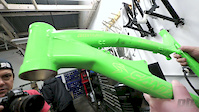Pinkbike.com
Powered by Outside
Video player is disabled while the embed window is open.
Copy and paste the HTML code below:
Color:
Size: X
|
| |
Pinkbike Visits The Santa Cruz Test Lab
Pinkbike Visits The Santa Cruz Test Lab
97 Comments
- + 113
that just drops all my doubts about a carbon frame
- + 10
CF is definitely stronger as far as maximum yield strength/etc. But there is a weird subtle tradeoff going with Aluminum.
Aluminum has the weaker maximum strength yield but will handle mostly everything. It's the good all around material.
CF has the stronger yield strength, but it's the small things that will eventually destroy it. Plus, IF the CF does fail, it's more likely to be catastrophic vs. bends of the ALU. Things like rock strikes, small crashes, low-sides, etc can eventually cause the CF to start unthreading and even develop holes. I've seen it before..it sucks. With the same situation, you are most likely to get some small dents or bounces off Alu. At that point, CF is unrideable vs. Alu still is ride-able (under non-catastrophic crashes, rock hits, etc).
Overall, although there are few exceptions, generally speaking the Alu is the more all-around performer material and has a better "flexible" durability, ultimately lasting longer (depends on cyclic loads/care). CF is the performance frame with top peak strength yields, however, it is the small things in the long run that can cause a failure.
-- Also, a thing to note is that CF is held by (usually?) 3k+ PSI epoxy glue, while it's extremely strong..doesn't all glue eventually lose its strength over time?
-- CF is laid in rows, all pointing to a special direction to maximize strength. Does that mean when the bike is hit "backwards" it'll be much weaker compared to hitting it "front-on"? I think so.
Aluminum has the weaker maximum strength yield but will handle mostly everything. It's the good all around material.
CF has the stronger yield strength, but it's the small things that will eventually destroy it. Plus, IF the CF does fail, it's more likely to be catastrophic vs. bends of the ALU. Things like rock strikes, small crashes, low-sides, etc can eventually cause the CF to start unthreading and even develop holes. I've seen it before..it sucks. With the same situation, you are most likely to get some small dents or bounces off Alu. At that point, CF is unrideable vs. Alu still is ride-able (under non-catastrophic crashes, rock hits, etc).
Overall, although there are few exceptions, generally speaking the Alu is the more all-around performer material and has a better "flexible" durability, ultimately lasting longer (depends on cyclic loads/care). CF is the performance frame with top peak strength yields, however, it is the small things in the long run that can cause a failure.
-- Also, a thing to note is that CF is held by (usually?) 3k+ PSI epoxy glue, while it's extremely strong..doesn't all glue eventually lose its strength over time?
-- CF is laid in rows, all pointing to a special direction to maximize strength. Does that mean when the bike is hit "backwards" it'll be much weaker compared to hitting it "front-on"? I think so.
- + 2
TLDR -
Alu: All-around performance, nothing great, nothing bad. Potential long-time Durability/flexibility per situation. Develops bends or weld cracks.
CF: Top performance, great strength, almost 2x stronger than Alu per weight ratio. Shorter lifespan/durability even against small "incidents". Develops catastrophic snaps, unthreads then holes making frame dangerous. Crash safety isn't too good. Even though it might survive a really bad case, the frame's intergrity may be damaged. Alu, has the chance to flex and negate some to that effect.
My 2 unbiased (tried) cents. Thank you for reading Mike Chang's random Asian fact of the day. Please come again.
Alu: All-around performance, nothing great, nothing bad. Potential long-time Durability/flexibility per situation. Develops bends or weld cracks.
CF: Top performance, great strength, almost 2x stronger than Alu per weight ratio. Shorter lifespan/durability even against small "incidents". Develops catastrophic snaps, unthreads then holes making frame dangerous. Crash safety isn't too good. Even though it might survive a really bad case, the frame's intergrity may be damaged. Alu, has the chance to flex and negate some to that effect.
My 2 unbiased (tried) cents. Thank you for reading Mike Chang's random Asian fact of the day. Please come again.
- + 5
@Spicey-Mike
Please back up your claims. You are making some huge claims about the life of carbon vs aluminum and providing zero sources. You left out aluminum's biggest issue, no fatigue limit. Without a fatigue limit even small stresses will cause damage. The cyclic stresses imposed on a bicycle will eventually cause a failure in an aluminum frame. Steel does posses a fatigue limit which is where its reputation of long life comes from. If you are still unsure of the roll fatigue limit plays then Wikipedia has your back.
Carbon Fibers fatigue properties are more complicated than a simple limit. Fiber orientation plays a significant roll in carbons ability to resist fatigue. This subject is best left for a google search
Please back up your claims. You are making some huge claims about the life of carbon vs aluminum and providing zero sources. You left out aluminum's biggest issue, no fatigue limit. Without a fatigue limit even small stresses will cause damage. The cyclic stresses imposed on a bicycle will eventually cause a failure in an aluminum frame. Steel does posses a fatigue limit which is where its reputation of long life comes from. If you are still unsure of the roll fatigue limit plays then Wikipedia has your back.
Carbon Fibers fatigue properties are more complicated than a simple limit. Fiber orientation plays a significant roll in carbons ability to resist fatigue. This subject is best left for a google search
- - 3
Hey,
What I've said is taking what I've come to see and you could say in that sense is slightly exaggerated for "effect" or sake of the point.
I do know the orientation of laying down the fibers and didn't think to write it down since it was only a little "summary." CF is ultimately very complicated as you said and I know that, however, I have seen graduals holes developing in CF frames from first hand experience and through the internet. That leads me to believe that CF has a great tolerance for pure strength yields, but if not protected, a CF frame can be susceptible to smaller issues to smaller and repetitive hits, etc. I wouldn't post something just for the fun of it but rather to have a basis on info and therefore inform of this simplistic situation regarding Alu vs. CF.
Alu of course has a cyclic load limit and we all know that nothing lasts forever. Alu is inherently a weak material, but like any other metal, it has conforming properties before failing to a certain extent. Things like flying rock hits are more likely to just put dents in the frame as we all know. Of course weld areas are more "dangerous" points of failure, but generally speaking, a single tube of Alu will be not as strong as CF but rather more "tolerant" of repetitive small stress hits. And yeah, steel frames are awesome. That's why we see extremely old bikes still working vs. Alu which seems to have a lower lifespan. But this is not about true cyclic fatigue limit. This is about real world application. Rock strikes are very dangerous to CF and literally cause unthreading of the frame where the frame's integrity is there on after compromised to that degree. Whereas Alu would most likely dent if that. So it leads me to my conclusion which has been drawn from first hand experience and knowledge of the element's properties. We see it here, Alu bent (at a lower PSI of course), and CF snapped. That does indicate a few of the points as well. Conclusion:
What I've said is taking what I've come to see and you could say in that sense is slightly exaggerated for "effect" or sake of the point.
I do know the orientation of laying down the fibers and didn't think to write it down since it was only a little "summary." CF is ultimately very complicated as you said and I know that, however, I have seen graduals holes developing in CF frames from first hand experience and through the internet. That leads me to believe that CF has a great tolerance for pure strength yields, but if not protected, a CF frame can be susceptible to smaller issues to smaller and repetitive hits, etc. I wouldn't post something just for the fun of it but rather to have a basis on info and therefore inform of this simplistic situation regarding Alu vs. CF.
Alu of course has a cyclic load limit and we all know that nothing lasts forever. Alu is inherently a weak material, but like any other metal, it has conforming properties before failing to a certain extent. Things like flying rock hits are more likely to just put dents in the frame as we all know. Of course weld areas are more "dangerous" points of failure, but generally speaking, a single tube of Alu will be not as strong as CF but rather more "tolerant" of repetitive small stress hits. And yeah, steel frames are awesome. That's why we see extremely old bikes still working vs. Alu which seems to have a lower lifespan. But this is not about true cyclic fatigue limit. This is about real world application. Rock strikes are very dangerous to CF and literally cause unthreading of the frame where the frame's integrity is there on after compromised to that degree. Whereas Alu would most likely dent if that. So it leads me to my conclusion which has been drawn from first hand experience and knowledge of the element's properties. We see it here, Alu bent (at a lower PSI of course), and CF snapped. That does indicate a few of the points as well. Conclusion:
- - 1
Alu, not as strong with maximum strength yield. Old "metal" reliability, tolerance to crashes/bends/dents, which are unlikely to decommission the frame. Cyclic loads? Not to high either.
CF extremely strong if created properly, can be compromised with crashes etc. If protected, considerably lessens the chance of any frame damage. Cyclic loads? Extremely high, but after a certain (unhuman amounts) of stress, can cause more sudden changes in the frame's integrity. I wonder if epoxy will wear out eventually too? Not sure what kind of epoxy is used, but I have personally heard that sometimes only 3.2k rated epoxy is used. v
CF extremely strong if created properly, can be compromised with crashes etc. If protected, considerably lessens the chance of any frame damage. Cyclic loads? Extremely high, but after a certain (unhuman amounts) of stress, can cause more sudden changes in the frame's integrity. I wonder if epoxy will wear out eventually too? Not sure what kind of epoxy is used, but I have personally heard that sometimes only 3.2k rated epoxy is used. v
- - 1
And if I could, I would buy a steel frame  Hopefully in the future people realize that steel technology can be applied to greatly exceed Alu's capabilities.
Hopefully in the future people realize that steel technology can be applied to greatly exceed Alu's capabilities.
- + 1
Spicy-Mike,
I've had numerous parts outside of the bike world failed due to work hardening. Aluminum when cycled in the elastic deformation phase work hardens and becomes susceptible to fracture. This is why materials like steel are used for connecting rods in engines. They get cycled a lot with pulses and fail earlier than aluminum.
- + 10
@Spicy-Mike: It's been a long time since I've read such uninformed nonsense about composite materials. CF "unthreading" and "developing holes" and "durability problems"?
When Mercedes developed the SLR they crash tested it and found no delaminations, so just to be sure, they crashed the same chassis a second time. Still no delaminations. I'd love to see what your Aluminium car would look like after 2 successive crashes into an offset deformable barrier.
Out of Aluninium and Carbon, only one suffers from fatigue, and it's Aluminium. Please inform yourself before spouting nonsense:
en.m.wikipedia.org/wiki/De_Havilland_Comet
I've spent the past 15 years doing material qualification, structural analysis and testing of wing sail race yachts and military and large commercial aircraft -all in Carbon- and it's been shown that fatigue just isn't a consideration. Neither is longevity of the matrix: our customers who spend $300 million on a new carbon plane expect to get 20-25 years out of the thing, which could easily spend 16 hours a day in the air, year after year, pressurised and travelling at nearly the speed of sound. Failure is not acceptable.
Most of the decent bike manufacturers will be using the same fibre and resin systems.
The only differences between a plane and a bike in terms of quality that you will see are:
- The amount of analysis that goes into a plane is (I hope obviously) on a completely different scale. A well designed bike should be both light and immensely strong and stay that way long after it's gathered dust in a shed somewhere. But how many are well designed?
- You won't ever find someone laying up aircraft components with their bare hands. The quality processes to guarantee a safe product in aerospace are extremely costly.
Weaknesses of composite materials:
You touched on an important point about the matrix (about the only thing you said that you got right): on its own it is weak. Very weak. 35 MPa weak. When you push and pull on a plate of carbon, the fibres are reacting the load (communicated from fibre strand to fibre strand by the matrix), but where the matrix takes significant amounts of load -such as unfoloding forces around corners- this is a natural weakness. With good design this point can be fairly well addressed, and you now hear about bike companies using "toughened" matrices, which I gather are tiny pieces of fibre that are put in the matrix to reinforce in the through-thickness direction.
The other is compression after impact.
Metals fatigue primarily in tension; in fibre reinforced composites, damage propagates under compression. That said, damage will only propagate once the combined compressive and shear strain level is high enough. To give you an idea, a delamination in a flat area about the size of your thumb print should be okay to live with. Delaminations in corners tend to be morre critical.
Can damage be fixed? Yes, but it's a fiddle to scarf the laminate back to undamaged material, lay up fresh material in the area with what I suspect would be an educated guess at the laminate lay-up. It would beed to be cured too - the original cure would have used heat and pressure to get a good quality laminate, and that's hard to achieve for a repair.
If I had an obviousl, large delamination in my carbon frame (if I could afford one) I'd probably use it as an excuse to upgrade to a newer frame.
Compare that with Aluminium: you're not likely to find a crack in the middle of a tube - it's far more likely to occur at a weld. Would you ride an alloy bike with a visible crack in a weld? Probably not a good idea. By the time it's visible on something as samll as a bike frame, it's probably in the unstable growth phase and is likely to fail before long. Can it be fixed? Yes, but you'd want to heat treat the frame afterwards or it would be prone to cracking there in the future.
Anyway, sorry for calling you out, and I hope this massive diatribe of mine has been interesting and/or informative at some level. I don't mean to be all preachy eaither; it's just that there's a crazy amount of minimformation out there, and most of it based on speculation.
When Mercedes developed the SLR they crash tested it and found no delaminations, so just to be sure, they crashed the same chassis a second time. Still no delaminations. I'd love to see what your Aluminium car would look like after 2 successive crashes into an offset deformable barrier.
Out of Aluninium and Carbon, only one suffers from fatigue, and it's Aluminium. Please inform yourself before spouting nonsense:
en.m.wikipedia.org/wiki/De_Havilland_Comet
I've spent the past 15 years doing material qualification, structural analysis and testing of wing sail race yachts and military and large commercial aircraft -all in Carbon- and it's been shown that fatigue just isn't a consideration. Neither is longevity of the matrix: our customers who spend $300 million on a new carbon plane expect to get 20-25 years out of the thing, which could easily spend 16 hours a day in the air, year after year, pressurised and travelling at nearly the speed of sound. Failure is not acceptable.
Most of the decent bike manufacturers will be using the same fibre and resin systems.
The only differences between a plane and a bike in terms of quality that you will see are:
- The amount of analysis that goes into a plane is (I hope obviously) on a completely different scale. A well designed bike should be both light and immensely strong and stay that way long after it's gathered dust in a shed somewhere. But how many are well designed?
- You won't ever find someone laying up aircraft components with their bare hands. The quality processes to guarantee a safe product in aerospace are extremely costly.
Weaknesses of composite materials:
You touched on an important point about the matrix (about the only thing you said that you got right): on its own it is weak. Very weak. 35 MPa weak. When you push and pull on a plate of carbon, the fibres are reacting the load (communicated from fibre strand to fibre strand by the matrix), but where the matrix takes significant amounts of load -such as unfoloding forces around corners- this is a natural weakness. With good design this point can be fairly well addressed, and you now hear about bike companies using "toughened" matrices, which I gather are tiny pieces of fibre that are put in the matrix to reinforce in the through-thickness direction.
The other is compression after impact.
Metals fatigue primarily in tension; in fibre reinforced composites, damage propagates under compression. That said, damage will only propagate once the combined compressive and shear strain level is high enough. To give you an idea, a delamination in a flat area about the size of your thumb print should be okay to live with. Delaminations in corners tend to be morre critical.
Can damage be fixed? Yes, but it's a fiddle to scarf the laminate back to undamaged material, lay up fresh material in the area with what I suspect would be an educated guess at the laminate lay-up. It would beed to be cured too - the original cure would have used heat and pressure to get a good quality laminate, and that's hard to achieve for a repair.
If I had an obviousl, large delamination in my carbon frame (if I could afford one) I'd probably use it as an excuse to upgrade to a newer frame.
Compare that with Aluminium: you're not likely to find a crack in the middle of a tube - it's far more likely to occur at a weld. Would you ride an alloy bike with a visible crack in a weld? Probably not a good idea. By the time it's visible on something as samll as a bike frame, it's probably in the unstable growth phase and is likely to fail before long. Can it be fixed? Yes, but you'd want to heat treat the frame afterwards or it would be prone to cracking there in the future.
Anyway, sorry for calling you out, and I hope this massive diatribe of mine has been interesting and/or informative at some level. I don't mean to be all preachy eaither; it's just that there's a crazy amount of minimformation out there, and most of it based on speculation.
- + 31
wow,so rigid, no eye protection while splitting carbon.?...ehhhhhh im going to send the boys at santa cruz 2 pairs of saftey goggles,i know it sounds lame but eyes dont grow back.
- + 0
I rather ride alu frames... Seen our newest hardtail from dartmoor bikes ?? biketopia.pl/rama-dartmoor-hornet-2017.html
- + 18
it would be interesting to see these tests done with frames from other manufacturers and see how they compare
- + 13
My only concern is that, while the breaking point of the carbon frames was very high compared to the aluminum ones, the failure mode was much more catastrophic than with the aluminum frames. Rather than somewhat gradually crumpling, the carbon frames just snapped when they finally gave way. Ultimately this is just something that leaves me thinking and wanting to learn some more physics/engineering!
- + 1
Yeah - with the aluminum you can see the point of plastic deformation, at that point the force has maxed yet the material can still strain - safe yet unfixable shape change. The carbon is just a catastrophic chain reaction between all the fibers.... still would love to have a carbon though 
- + 4
in my opinion coming from an engineering background ... i dont understand why bike manafacturers dont add a thin layer of aluminium or titanium under the carbon so it has the best of both worlds and if it does snap your not landing on your chops you will just have a bent frame like aluminum frames do under failure .... just cant understand it .... yeah for sure make the rear swing arm from carbon for the flex but the common point of fracture is the toptube and downtube so why not reinforse them ? its not like it would add much weight a small peice of hydroformed metal under all that carbon ? :s still pretty cool to see how they test it haha
- + 0
I know this was months ago, but overlaying it over Alu would potentially make things cheaper for manufacters too since they can just "cast" CF over a that skeleton frame you talked about.
I think the reason they don't do it is cause:
a) Weight issues.
b) Why do it the first place if CF is strong enough already?
c) The Alu's physical properties such as flex, expansion, etc may not be compatible with a CF's physical properties when put together. You may get something that'll flex inside but not flex outside and cause more stress or whatever it may be.
I do agree tho, it would be smart. What I would change is:
1) CF main body.
2) CF frame is reinforced for extra durability @ all joints.
3) CF has molded small "inlay" channels to insert thin sheets of Alu for integrated protection, like a Downtube Guard but integrated.
4) Option 1: Have CF internals be molded around "Disc Walls" that act like struts every 2 inches or so.
5) Option 2: Have CF internals filled with a solid foam-like (light) substance which is filled around a solid, light piece of Alu Rods that conjoin at all pivot points. Just like the internal frame you talked about, but a rod acts like an internal frame while substance suspends the rod and provides better vibration reductions. Also, upon crashes, the foam would dissipate pressure over the CF frame better, rather at one point..helping durability.
I think the reason they don't do it is cause:
a) Weight issues.
b) Why do it the first place if CF is strong enough already?
c) The Alu's physical properties such as flex, expansion, etc may not be compatible with a CF's physical properties when put together. You may get something that'll flex inside but not flex outside and cause more stress or whatever it may be.
I do agree tho, it would be smart. What I would change is:
1) CF main body.
2) CF frame is reinforced for extra durability @ all joints.
3) CF has molded small "inlay" channels to insert thin sheets of Alu for integrated protection, like a Downtube Guard but integrated.
4) Option 1: Have CF internals be molded around "Disc Walls" that act like struts every 2 inches or so.
5) Option 2: Have CF internals filled with a solid foam-like (light) substance which is filled around a solid, light piece of Alu Rods that conjoin at all pivot points. Just like the internal frame you talked about, but a rod acts like an internal frame while substance suspends the rod and provides better vibration reductions. Also, upon crashes, the foam would dissipate pressure over the CF frame better, rather at one point..helping durability.
- + 6
During the JRA test, you can hear the weave separating and popping at 800 lbs or so. That's irreparable damage, folks. Also, all it takes is a chip, and your frame will begin to unravel. Carbon is great, sure, but it's not the wonder material these guys are making it out to be.
- + 6
During the JRA test, you can see the aluminum is starting to deform at well under 1000lbs. That's irreparable damage too. All it takes is a small crack and the frame will begin to unravel... aluminum is great, sure, but it's not the wonder material everyone thinks it is.
I think what people are forgetting is that carbon is lighter and rides nicer. It has great characteristics on its own merit. So whether or not it is stronger than aluminum is really a secondary concern. If it is exactly on par, we have a winner. If it is even 10% weaker, then I think the benefits still outweigh the disadvantage. But I don't think that's the case; I'm pretty convinced it is at least on par, or slightly to significantly stronger.
It seem like for carbon to be a winner in most people's eyes, it has to be twice as strong, half as heavy and survive whatever any hack can throw at it. Well, that is not going to happen. Instead what we are getting is aluminum frames that are lighter than their predecessors and they dent easily and all the carbon haters call that progress.
Perhaps aluminum is better at surviving certain situations. But there is little doubt that carbon is better at other situations. End result? Probably a similar overall chance you will break your frame as before, except it's now lighter and rides better. And the carbon V10 costs the same as the old Aluminum one did. I've broken a total of 5 frames including an aluminum V10 and have not yet broken a carbon one, but I will give it an honest try.
I think what people are forgetting is that carbon is lighter and rides nicer. It has great characteristics on its own merit. So whether or not it is stronger than aluminum is really a secondary concern. If it is exactly on par, we have a winner. If it is even 10% weaker, then I think the benefits still outweigh the disadvantage. But I don't think that's the case; I'm pretty convinced it is at least on par, or slightly to significantly stronger.
It seem like for carbon to be a winner in most people's eyes, it has to be twice as strong, half as heavy and survive whatever any hack can throw at it. Well, that is not going to happen. Instead what we are getting is aluminum frames that are lighter than their predecessors and they dent easily and all the carbon haters call that progress.
Perhaps aluminum is better at surviving certain situations. But there is little doubt that carbon is better at other situations. End result? Probably a similar overall chance you will break your frame as before, except it's now lighter and rides better. And the carbon V10 costs the same as the old Aluminum one did. I've broken a total of 5 frames including an aluminum V10 and have not yet broken a carbon one, but I will give it an honest try.
- + 4
There's a lot of creaking before it actually snaps, is the frame still structurally sound if stressed hard, but below breaking point? At least several manufacturers won't warranty carbon frames that are clamped in a bike carrier - no good at resisting crushing forces as opposed to compression, so they are a pain to transport.
---owner of a carbon bike and an Alu one.
---owner of a carbon bike and an Alu one.
- + 1
I have broken way more Aluminum bikes vs. Carbon, a ratio of 14 to 3. So nothing is bullet proof, or in my case cheese burger and beers/ fat ass proof.
What scares me the most is the folks testing, who have NO EYE PROTECTION! dude safety glasses can look cool. Carbon fiber shards are pretty much like glass. Not cool to have removed from your fingers let alone from your eye.
What scares me the most is the folks testing, who have NO EYE PROTECTION! dude safety glasses can look cool. Carbon fiber shards are pretty much like glass. Not cool to have removed from your fingers let alone from your eye.
- + 1
As a matter of interest ,speaking for myself I've heard a few times of someone breaking a Carbon frame or wheels but never their aluminium one. My Forks are in Fox repair and the Bike shop offered me a Bike to ride which is an expensive Carbon one and said about 6 times or more If " I BREAK IT I buy it " ! They never carried on like that when I had one of their fairly expensive Aluminium Demo Bikes for 3 days , so is that telling me something 
- + 3
my physics isnt great....BUT when you double the height wont the force be 4 times greater??? IF im right (and im not sure) that would make that test even more impressive
- + 2
You have to calculate the speed of the impact using gravitational constant. Ignoring air resistance, after 450mm the weight would be falling at 2.96 meters per second but after 900mm it would be falling at 4.2 meters per second. Which would mean the force would be 1.42 times greater. I hope I didn't leave anything crucial out.
- + 1
This is the raddest thing I've seen since the moots guy used to lay a Ti frame on the ground and bounce up and down on the rear triangle sometimes touching the dropouts together. Then he would mount a wheel in it... Perfect every time; until it failed, but it was impressive, but this is of the chain...
- - 1
HOLY SHIT, i could not do that to a frame or i may could if frames were free. i alwas say that carbon is the worst material for a bike, i see it handle and beat all the tests, but why i say carbpn do not work and hope someone give me the answer.
i always think that when a carbon frame hits a rock it may not looks like is broken or crack, but how about inside the frame it may cracks, i think thats is like a window if you hit it in a point with a rock lets say, not only where the rocks hits window breaks, it expands on the rest of it, doesnt happen the same to carbon?... that concrete test was brutal very eye opening, i just wonder that.
i always think that when a carbon frame hits a rock it may not looks like is broken or crack, but how about inside the frame it may cracks, i think thats is like a window if you hit it in a point with a rock lets say, not only where the rocks hits window breaks, it expands on the rest of it, doesnt happen the same to carbon?... that concrete test was brutal very eye opening, i just wonder that.
- + 8
unless your name is josh bender i think you will struggle to get anywhere near that sort of impact riding your bike, looks pretty bombproof to me.
- + 3
Completely agree with Jiffla, I recently purchased a nomad carbon myself. Never going back as long as I have the funds to keep myself on carbon. I had the same inhibitions but then I realized you know? I like to think of myself as a good rider but in retrospect I probably will never be able to put my bikes through the same fatigue that a pro rider who's riding at the highest level will and bikes these days stand up to that, especially carbon bikes.
- + 1
Made me think again about carbon frames that's for sure, I was convinced that they were good for nothing but some light XC!
- + 3
At least Santa Cruz frames are. I don't think that every carbon frame is that much better than an alu one. I saw a few Salcano XC carbon frames (some turkish maker), all of them cracked, one cracked apart on 3 places, and the rear tire "ate" the seat and the chainstays. I takes much more of engineering to make a reliable and strong carbon frame.
- - 2
Way to go with faux engineering. Biggest piece of marketing concocted BS i have literally seen.
1st test, strain rate is not representative of real life, why even pay for the equipment to bother?
2nd test, does actually show the drawbacks of aluminium as a material, its poor fracture toughness. Though get a steel frame into the same test, we'd soon see whose fracture toughness is better, steel or carbon. though the quality, composition, orientation, heat treatment of the aluminuim is not known. We are also not just comparing material properties, we are also comparing designs, an aluminuim frame designed in such a way could attain the same values in this test as a carbon frame. For engineering design, how can you actually use this data? By this i mean what equations or values can you actually develop as an engineering aid? It's only benefit is marketing! these tests aren't conclusive of which is a better material to go with. (i'm not anti carbon, give me a carbon frame any day of the week, i just don't like the manner in which this video is misleading).
1st test, strain rate is not representative of real life, why even pay for the equipment to bother?
2nd test, does actually show the drawbacks of aluminium as a material, its poor fracture toughness. Though get a steel frame into the same test, we'd soon see whose fracture toughness is better, steel or carbon. though the quality, composition, orientation, heat treatment of the aluminuim is not known. We are also not just comparing material properties, we are also comparing designs, an aluminuim frame designed in such a way could attain the same values in this test as a carbon frame. For engineering design, how can you actually use this data? By this i mean what equations or values can you actually develop as an engineering aid? It's only benefit is marketing! these tests aren't conclusive of which is a better material to go with. (i'm not anti carbon, give me a carbon frame any day of the week, i just don't like the manner in which this video is misleading).
- + 4
I understand what your saying but I don't find the video all that misleading. They wern't claiming these as accurate to the core engineering tests. It was simply showing the difference between two equivalent frame designs with two different materials. The data wasn't meant to compare outside of Santa Cruz, just show that -their- carbon frames can take more punishment than -their- alu. frames.
- + 2
@ FBM-BMX: "These tests aren't conclusive of which is a better material to go with"??? Did we just watch the same video? Im sorry but if you can make a lighter, stronger frame with the same exact geometry (carbon vs. aluminum), why would you not? You state that an aluminum frame could be designed in such a way that can attain the same test results... yeah you could. But your frame would be 10 pounds heavier. Marketing gimmick? These are some of the ways that frame design is tested (minus the smashing into concrete corner). I realize the free weight drop seems a little jury-rigged, but even though there are no wires and sensors hooked up engineers are still gaining purposeful knowledge. Just accept the fact that carbon is f*cking awesome. I mean what other way would you want to portray carbon vs. aluminum? This video addresses nearly every one of carbon sceptic's main arguments. Square edge hits, hard impacts on head tube, slow compression placed on head tube...
- + 5
It should also be noted that these are just two of their many tests. We showed tests that would be interested and dramatic on video. Their fatigue tests, while maybe more representative of more typical everyday riding abuse, aren't nearly as interesting to watch and we would have been there for a very long time watching nothing happen.
- + 2
I was wasted at the time of writing that, i did somewhat over-react. I guess this video is good for shaking off the fear of breaking carbon for the masses. Carbon is an worthy avenue for MTB frames to go.
I just saw the tests as mickey mouse, tests that riders pockets are funding. I was hoping for more.
- + 2
just copy and paste the link at the top of this page into your fb account
like: www.pinkbike.com/video/243228
like: www.pinkbike.com/video/243228











